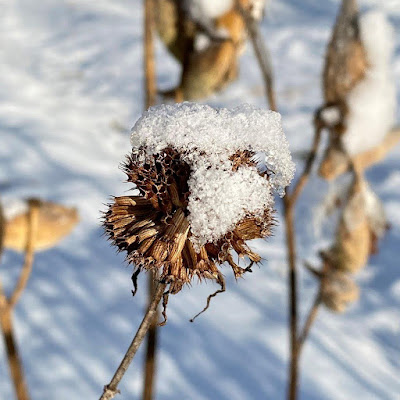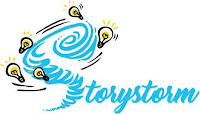Book launches are so instructive for writers and illustrators. Not only do we get to see authors in action, we also learn more about craft, how to create an interactive online experience, and what kind of questions audience members ask.
I'm excited to share my review, mentor text musings, and our chat and how Cindy made the book launch special. Read on.
Review of NIGHT BECOMES DAY: CHANGES IN NAUTRE
Over the years, I have become a big fan of Millbrook Press' nonfiction picture books that feature STEM concepts with paired with photography and striking design. Cindy's concept picture book about changes in nature through the seasons blends science and observation in a way that will inspire readers to find wonder in their own natural environment.
The photos work with the text and typography to show and highlight how nature transforms over time: fruit becomes flower, small changes versus big changes with wind and water, how some change is fast while others take centuries.
Author Argentine uses lyrical language ("The little oak tree grows, adding leaves and limbs.") and kid-friendly examples ("...it will offer shade, shelter, and a perfect pace to climb or rest.") to make science of change instructive yet everyday- accessible. The ending harkens back to the beginning in a satisfying, poetic manner.
Back matter includes an Author's Note on the connectedness of living and nonliving things that invites readers to ponder ecology and our place in it. Educators will appreciate further back matter that weaves geology, botany, biology, chemistry, and physics together. Night Becomes Day will hook many audiences for a variety of reading purposes.
Craft Chat with Cindy Argentine
KH: You and debut author S. K. Wenger created such an interactive book launch through The Writing Barn. Can you explain the audience participation element for those who didn’t attend? What advice do you have for authors new to online formats: setup, venue, length of program, setting up ways to purchase books?
CA: I’m so glad you enjoyed our virtual book launch. Shaunda (S.K.) and I made it interactive to add fun and weave in fascinating facts. We each gave a 20-minute presentation using PowerPoint, coordinating in advance on our content and approach. To engage our audience, we interspersed “quiz” questions every 5-10 minutes and awarded prizes to the winners. The “quiz” questions related to topics in our books. Night Becomes Day is all about transformations that happen in nature. So, for one of my questions, I showed a photo of a blossom and asked whether it would transform into an (a) orange, (b) apple, (c) strawberry, or (d) magnolia. The answer was (b) apple—it was a photo from a tree in my backyard. The first person to type “b” in the Zoom chat won a bookstore credit or copy of my book. Other questions involved surprising facts about snowflakes and deserts (which relate to two other transformations in Night Becomes Day). Many attendees played along, which made it exciting.
For new authors looking into online events, I have these suggestions:
· Do a “practice run” for your critique partners in advance. That will make you feel more comfortable with the technology and help you tweak any spots in the presentation that seem slow or confusing.
· Our venue for the book launch was The Writing Barn in Texas. They were great to work with! I’ve also given webinars through Indiana SCBWI and the Montessori Family Alliance. At each venue, having a coordinator to host and provide tech support was wonderful.
· As for length of program, I have done three 45-minute presentations with 15-minute Q&A’s afterwards. That has worked well.
· Setting up ways to purchase books may take some work. I recommend partnering with an independent bookstore and supporting local bookshops when possible. That said, be aware that stores have different sorts of websites and online capabilities. Talk with your store manager in advance about the best way for people to shop with them or receive signed copies.
· One more bit of advice: it’s fun to partner with another writer! I really enjoyed partnering with SK Wenger. Our nonfiction books have different subjects and styles, but Shaunda and I discovered we as authors have a lot in common. Hearing from two authors broadened the program’s content and appeal.
KH: Like many authors, you’ve had other careers. How did you transition from being an environmental consultant to children’s author? What skill sets transferred from one career to another?
CA: Interesting question! My career transition happened in stages as my family grew. After the birth of my second child, I decided to leave corporate consulting and pursue more flexible work. I wanted something fulfilling that I could do from home and that didn’t require much travel. I have always been interested in both writing and science, and writing nonfiction for kids turned out to be a fun way to combine these interests.
Many skills transferred! Even as an environmental consultant, I was writing every day. I wrote letters, technical reports, and regulatory newsletters for clients. One firm even asked me to lead an in-house seminar on writing for their employees! So, writing itself was a primary skill that transferred. Both careers also require inquisitiveness, research, continuous learning, and problem-solving.
KH: The book layout and comparison/contrast structure works perfectly for this topic. How did editor Carol Hinz and you work together on design, edits?
CA: Thank you! The compare/contrast structure was an early feature of my manuscript and was in place when Carol Hinz acquired it. The primary change Carol suggested did not alter the structure but improved the wording of the contrasting pairs. She suggested I make some of the comparisons more “science-y.” I gave that a lot of thought and adjusted three of the six pairs of adjectives to make them more objective and measurable. For example, “small” versus “big” stayed the same, but “familiar” and “mysterious” became “above” and “below” in a section about clouds and caves. These word choices were clearer for young readers and science teachers.
They book layout and design was handled by Mary Ross and the Lerner art department. I love the way they put opposites on facing pages with a diagonal line separating them. Visually, that reflects the meaning of the words. Carol shared several drafts of the layout with me as it developed. I appreciated the opportunity to comment on the design and photo selection.
KH: Being a back matter aficionado, I applaud the 3 pages of back matter. Did you ask for that or make that suggestion suggest when you submitted the book to Millbrook?
CA: I’m a “back matter aficionado,” too! I wrote and submitted the back matter with the original manuscript. I had even more, but we weren’t able to fit it all in the finished book. If readers would like a glossary, teacher’s guide, or additional resources, please check out my website at https://cynthiaargentine.com/resources. The glossary and standards-aligned classroom activities are available as free downloads!
KH: I am taking classes now at the Writing Barn with Bethany Hegedus. Did you take course there? What courses/webinars do you recommend for writers interested in writing nonfiction, particularly science?
CA: I have taken a couple courses with Bethany Hegedus, and I recommend her and The Writing Barn! Interestingly, I first met Bethany at the Highlights Foundation in Pennsylvania, where she and Cynthia Levinson taught an excellent course on picture-book biographies. A year or so after that, I attended a weekend workshop at The Writing Barn. I also participated in The Writing Barn’s Courage to Create (CtC) program for six months. That program connects writers with other writers, editors, and agents through online monthly meetings. One of Bethany’s goals with the CtC program is to support authors and encourage them to continue creating and submitting, believing “your yes is next,” as she likes to say. All these programs were valuable and helped me revise or market my work.
I would recommend a few other courses as well, particularly for nonfiction writers:
· Beachside Nonfiction Retreat with Jennifer Swanson and Candace Fleming
· Nonfiction Fest, an online event sponsored by the Nonfiction Chicks
· Nonfiction programming offered by various SCBWI chapters throughout the year (look for break-out sessions on nonfiction and webinars by regional chapters)
· The Highlights Foundation has annual science-writing workshops. I have not attended these, but I know that past leaders, including Heather Montgomery and Miranda Paul, have provided excellent instruction.
KH: What are you working on now?
CA: I have many projects in the works! One is a picture-book biography of a woman entrepreneur who was a forerunner in the “maker” field. Another is a short, rhyming story based on a winter adventure. I’ve also got a tongue-in-cheek manuscript about surprising animal adaptations and a collection of seasonal poems. I’ve got ideas for a STEAM poetry collection, a middle-grade science title, and a concept story with SEL and STEAM ties. I’m in the process of submitting to agents and hoping to find one in the coming year. Thank you for asking! It’s a pleasure to appear on your blog.
KH: Cindy, it was a pleasure chatting with you and nonfiction. Congrats on this debut.
You can find Cindy here on social media:
Website: https://cynthiaargentine.com/
Twitter: @CindyArgentine
Instagram: https://www.instagram.com/argentine_writer/
Pinterest: https://www.pinterest.com/cynthiaargentine/_created/






















